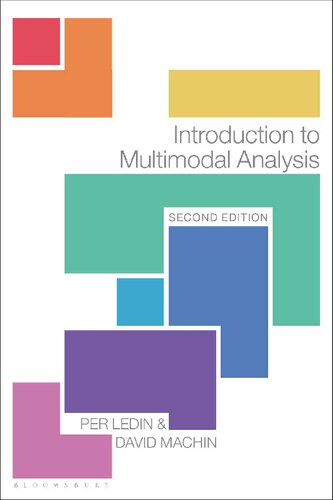Introduction to Multimodal Analysis 2nd Edition by Per Ledin 9781350069152 1350069159
$50.00 Original price was: $50.00.$25.00Current price is: $25.00.
Introduction to Multimodal Analysis 2nd Edition by Per Ledin – Ebook PDF Instant Download/Delivery: 9781350069152, 1350069159
Full download Introduction to Multimodal Analysis 2nd Edition after payment

Product details:
• ISBN 10:1350069159
• ISBN 13:9781350069152
• Author:Per Ledin
Introduction to Multimodal Analysis
Introduction to Multimodal Analysis is a unique and accessible textbook that critically explains this ground-breaking approach to visual analysis. Now thoroughly revised and updated, the second edition reflects the most recent developments in theory and shifts in communication, outlining the tools for analysis and providing a clear model that students can follow. Chapters on colour, typography, framing and composition contain fresh, contemporary examples, ranging from product packaging and website layouts to film adverts and public spaces, showing how design elements make up a visual language that is used to communicate with the viewer. The book also includes two new chapters on texture and diagrams, as well as a helpful image index so students can clearly understand how images and multimodal texts can be analysed from different perspectives. Featuring chapter summaries, student activities and a companion website hosting all images in full colour, this new edition remains an essential guide for students studying multimodality within visual communication in linguistics, media and cultural studies, critical discourse analysis or journalism studies.
Introduction to Multimodal Analysis 2nd Table of contents:
1 What is multimodal analysis?
The idea of choice in communication
Semiotic choices
Materials and affordances
Discourse
Discourses and social practices
The shift to multimodal communication
Technologization
Integrated design
A new commodified communication setting moral standards
Coding of semiotic resources
Distinctions
Contextualizations
Configurations
Identifying codes
Inventories
The commutation test
2 Pictures and images
A semiotic approach: Denotation and connotation
Denotation
Connotation
Three further points
Carriers of connotation
The meaning of objects in images
Settings
Visual depictions of people
Representing participants
Individuals and groups
Distance
Categorization
Anonymization
None representation
Actions in images
Emotional processes
Mental processes
Verbal processes
Material processes
3 Modality: Experiencing the world through images
The origins of modality as a linguistic concept
Modality markers and scales
Degrees of the articulation of detail
Degrees of articulation of the background
Degrees of articulation of depth
Degrees of illumination – articulation of light and shadow
Degrees of articulation of tone
Degrees of colour modulation
Degrees of colour saturation
Degrees of articulation of colour differentiation
Kinds of visual modality
Naturalistic modality: The truth of our eyes
Sensory modality: The truth of our feelings
Abstract or technical modality: The truth of the intellect
Perspective in images
Engagement and frontal perspective
Direct address
Potential address
Non-frontal perspective
Angles
Horizontal and oblique angles
Vertical angle
Oblique angles
Distance
4 The meaning of colour in visual design
Patterns in colour as a semiotic resource
Colour as a semiotic system
How colour communicates ideas
How colour communicates attitudes
How colour creates coherence
The value of colours
Semiotics of colour
The dimensions of colour
Brightness
Saturation
Purity
Modulation
Differentiation
Luminosity
Fluorescence
Hue
5 The meaning of typography
Typeface and design
Typography as a semiotic system
How typeface communicates ideas
How typeface communicates attitudes
How typefaces create coherence
Inventory of typographic meaning potential
Weight
Expansion
Slope
Curvature
Connectivity
Orientation
Regularity
Flourishes
6 Textures and materiality
Texture as a semiotic system
How textures communicate ideas
How textures communicate attitudes
Textures and composition
The dimensions of texture
Rigidity
Relief
Regularity
Naturalness
Viscosity
Liquidity
Materials
Wood
Glass
Concrete
Brick
Paper
Carton/card
Plastics
Metal
Stone
7 Composition and page layout
Some basic principles of salience
Potent cultural symbols
Size
Colour
Tone
Focus
Foregrounding
Overlapping
Framing
Segregation
Separation
Integration
Overlap
Rhyme
Contrast
Images and composition: Coordination and hierarchies
Photographs, hierarchies and rhyming
Photographs and coordination
8 Diagrams and flow charts
Classification
Classification and writing
Processes
Imperatives
Infinitives
People
Visual classifications
Graphic shapes
Size and weight of graphic elements
Composition and orientation
Centre-margin
Bottom-up
Left–right
Cycles
Pathways
Networks
Composition and grouping
Framing
Symbolization
Causality
Directional flow
Temporality
Bibliography
Image index
Index
Copyright Page
Read Less
People also search for Introduction to Multimodal Analysis 2nd:
introduction to multimodal analysis 2nd edition
multimodal analysis example
introduction to meta-analysis 2nd edition pdf
multimodal analysis essay example
introduction to meta-analysis 2nd edition
You may also like…
Mathematics - Analysis
Children s Books Education Reference
Reading the Visual An Introduction to Teaching Multimodal Literacy Frank Serafini
Mathematics - Analysis
Reference - Other Reference By Subject
How to Do Critical Discourse Analysis: A Multimodal Introduction Second Edition Machin
Computers - Organization and Data Processing
Introduction to Scientific Computing and Data Analysis 2nd Edition Mark H. Holmes
Engineering - Civil & Structural Engineering
Biology and other natural sciences - Genetics
Education Studies & Teaching - School Education & Teaching
Technique - Electronics: Signal Processing











